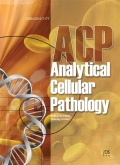Authors: Liu, Jonathan T.C. | Loewke, Nathan O. | Mandella, Michael J. | Levenson, Richard M. | Crawford, James M. | Contag, Christopher H.
Article Type:
Review Article
Abstract:
Advances in optical designs are enabling the development of miniature microscopes that can examine tissue in situ for early anatomic and molecular indicators of disease, in real time, and at cellular resolution. These new devices will lead to major changes in how diseases are detected and managed, driving a shift from today's diagnostic paradigm of biopsy followed by histopathology and recommended therapy, to non-invasive point-of-care diagnosis with possible same-session definitive treatment. This shift may have major implications for the training requirements of future physicians to enable them to interpret real-time in vivo microscopic data, and will also shape the emerging
…fields of telepathology and telemedicine. Implementation of new technologies into clinical practice is a complex process that requires bridging gaps between clinicians, engineers and scientists. This article provides a forward-looking discussion of these issues, with a focus on malignant and pre-malignant lesions, by first highlighting some of the clinical areas where point-of-care in vivo microscopy could address unmet needs, and then by reviewing the technological challenges that are being addressed, or need to be addressed, for in vivo microscopy to become a standard clinical tool.
Show more
Keywords: In vivo microscopy, molecular imaging, biomedical optics, microendoscopy, endomicroscopy, optical sectioning, optical biopsy, biomarker, cancer, dysplasia, image-guided therapy, telepathology
DOI: 10.3233/ACP-2011-011
Citation: Analytical Cellular Pathology,
vol. 34, no. 3, pp. 81-98, 2011
Price: EUR 27.50





